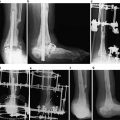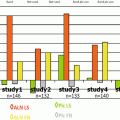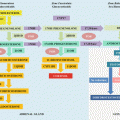Weight (kg)
Units of insulin:g of CHO
25
1:30
45–49
1:16
49.5–58
1:15
58.5–62.5
1:14
63–67
1:13
67.5–76
1:12
76.5–80.5
1:11
81–85
1:10
85.5–89.5
1:9
90–98.5
1:8
99–107.5
1:7
≥108
1:6
With regard to children and adolescents, since a child’s weight is half that of an adult, 1 unit for every 30 g of carbohydrates is taken, if the child weighs on average 25 kg. Another aspect to be considered is that due to the action of the growth hormone present in children and adolescents, there is greater resistance to insulin, which makes control in this type 1 diabetic population difficult. Individualized and monitored action to evaluate pre- and postprandial blood glucose levels should be a priority when overseeing the adjustment of the doses of insulin [12, 15].
Another important aspect of glycemic control for those who use insulin therapy is to choose the appropriate insulin needle, which needs to reach the subcutaneous tissue; if the needle is oriented incorrectly, it will make all glycemic control difficult, even if carbohydrate counting is done satisfactorily.
Exercises
Physical activity is an important pillar in the control of blood glucose because it enhances insulin sensitivity and control of weight [11, 16]. Excessive exercise can elevate blood sugar levels or foster the emergence of hypoglycemia. Decompensated patients should only start exercise after their glucose levels have been adjusted because of the action of counter-regulatory hormones.
What Is the Effect of Alcohol on Blood Glucose?
Alcohol has 7 cal for 1 g. It is metabolized, enters the Krebs cycle, and provides energy, referred to as empty calories, because it contains neither vitamins nor mineral salts. Starting at 15 g of ethanol for women and 30 g for men, there will be an increase in blood pressure and glucose levels; 30 g of ethanol is the equivalent of two shots of whisky, two shots of vodka, and two glasses of wine for men, and the amounts for women should be approximately half of these.
The liver is an organ that stores glycogen reserves, but alcohol is metabolized in the liver. With a higher consumption of ethanol, glycogen is depleted and alcohol degraded, thus leading to the risk of hypoglycemia. The consumption of alcoholic drinks initially raises blood glucose levels and subsequently, with increased consumption, will lead to hypoglycemia [6]. In clinical practice, it is recommended that alcohol be consumed after eating in order to avoid precipitating the onset of hypoglycemia. Assessing blood sugar levels before and after ingesting alcohol will indicate the proper amount of insulin. If blood glucose is below 70 mg/dL, alcohol should not be ingested.
How Is the Amount of Carbohydrates in a Meal to be Assessed?
This assessment may be made by weighing food, but this is a more cumbersome way to do so. Using tables of domestic measures and consulting a manual that counts carbohydrates, in which such measures are used and the amounts of carbohydrates and calories are given in alphabetical order [12], are recommended. Manuals of this kind are already available in paperback. An iPhone app such as Diamigo is already available on the Brazilian market and is a carbohydrate counting program. It is important to note that support and feedback from a professional nutritionist who is a specialist in this field is of great importance in the process of learning and controlling desirable glycemic targets, but is not a substitute for the nutritionist–patient relationship [16, 17]. The basics of carbohydrate counting are shown in Table 39.2.
Table 39.2
Counting carbohydrates
Group | Example/portions | Amount of carbohydrate |
|---|---|---|
Bread | ½ morning roll/1 slice of sliced bread/3 tablespoons of rice/3 water and salt biscuits/½ cup of spaghetti | 15 g |
Milk | 1 240 ml cup of milk/1 cup of yoghourt | 12 g |
Fruit | 1 medium-sized apple/1 medium-sized pear/3 slices of mango/1 small banana | 15 g |
Vegetables | 1 teacup of raw vegetables/½ teacup of cooked vegetables | 5 g |
Meat | 1 small steak/3 soupspoons of minced beef/2 chicken drumsticks | 15 g |
Fat | 1 teaspoon of margarine | 0 g |
Effects of Food on the Blood Sugar Level
Carbohydrates raise the blood sugar level by 100 %, proteins by 60 %, and fats by 10 % on average. Carbohydrates raise glucose linearly, i.e., the more the carbohydrates are consumed, the more the glucose level rises. Protein increases the blood glucose level on account of the glycogenetic amino acids, which play a part in gluconeogenesis, and fat, because it is ingested more slowly, and maintains glucose levels higher for longer, but does not alter the glucose level as the other macronutrients do.
Some diabetics already use two doses of insulin, one immediately after the meal and the other 2 h later to correct the effect produced by high-fat foods such as pizza, Brazilian beef, and pork stew. The glycemic load of a food is affected by the content of fats, fibers, proteins, coction, and also factors inherent in the individual [6]. As regards fibers, it is recommended that if a food has more than 5 g of fiber, this should be subtracted from the total carbohydrate content of the meal, since fiber decreases the glycemic response [12].
One of the priority aspects of carbohydrate counting is to understand the size of the portion of food, because what will determine the amount of insulin is the amount of carbohydrates in the meal [17]. In performing the carbohydrate count it is important to (1) identify the amount of carbohydrates per meal per day; (2) match the portions of carbohydrates to the meal; and (3) practice the size by measuring or weighing or using as a reference the replicas of food used by nutritionists [12].
Stay updated, free articles. Join our Telegram channel

Full access? Get Clinical Tree






